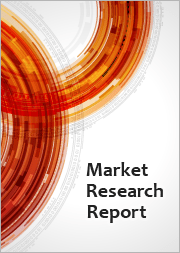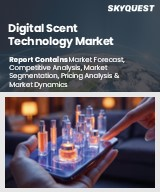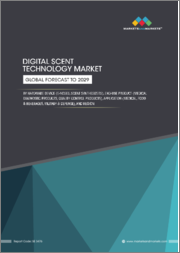
|
시장보고서
상품코드
1642760
디지털 후각 시장 : 유형별, 최종 이용 산업별, 지역별(2025-2033년)Digital Scent Market by Type (Scent Synthesizer, E-Nose), End Use Industry (Military and Defense, Healthcare, Food and Beverage, Waste Management (Environmental Monitoring), and Others), and Region 2025-2033 |
||||||
세계의 디지털 후각 시장 규모는 2024년 13억 달러에 달했습니다. IMARC Group은 향후 시장이 2033년까지 26억 달러에 이를 전망이며, 2025년부터 2033년까지 8.0%의 성장률(CAGR)을 나타낼 것으로 예측했습니다. 헬스케어 산업의 현저한 성장, 소비자의 지출 능력의 상승, 광범위한 연구개발(R&D) 활동이 시장을 견인하는 주요 요인입니다.
디지털 후각은 전자코 및 향기 합성기와 같은 하드웨어 부품을 사용하여 디지털 수단을 통해 냄새를 감지, 수신 및 전달하는 기술을 말합니다. 이 기술은 다양한 유형의 냄새를 감지, 시뮬레이션, 복제 및 생성하는 데 도움이 되는 가스 센서와 같은 하드웨어 장치 및 전자 부품을 사용합니다. 디지털 후각은 화학 센서를 사용하여 냄새의 화학 조성을 분석하고 인터넷 및 기타 디지털 미디어를 통해 전송할 수 있는 디지털 신호로 변환합니다. 몰입감의 향상, 질병의 진단, 제품의 맛이나 향기의 개선, 가스 누출의 검지 등의 환경 모니터링에 널리 이용되고 있습니다. 그 결과, 디지털 후각은 군 및 방위, 헬스케어, 식음료(F&B), 폐기물 관리(환경 모니터링)의 각 업계에서 폭넓게 응용되고 있습니다.
디지털 후각 시장 동향 :
세계의 헬스케어 산업의 현저한 성장은 시장의 밝은 전망을 창출하는 중요한 요소 중 하나입니다. 디지털 후각 기술은 환자의 호기와 체액의 향기를 기반으로 의사가 특정 질병을 진단하는 데 널리 사용됩니다. 또한 공기의 질을 모니터링하고 환경에서 유해한 가스와 오염물질을 감지하기 위해 전자코가 널리 채택되고 있는 것도 시장 성장을 뒷받침하고 있습니다. 이에 따라 대기, 토지, 물로의 유기 및 무기 오염물질의 배출이 증가하여 사람, 식물, 동물에 심각한 건강 위험을 초래하여 대중들 사이에서 환경 의식이 높아지고 시장의 성장에 긍정적인 영향을 미치고 있습니다. 이와는 별도로 디지털 후각에 인공지능(AI)을 통합함으로써 특정 냄새를 보다 정밀하고 정확하게 감지하고, 개인의 취향이나 특정 이용 사례에 근거한 커스텀 향기프로파일을 작성하는 것이 시장 성장에 탄력을 주고 있습니다. 또한 식육에서 방출되는 가스에 반응하여 시간이 지남에 따라 색이 변화하는 '바코드'로 구성된 포유류의 코를 모방함으로써 식육의 신선도를 확실히 평가하는 인공향기 시스템의 발매가 시장 성장에 긍정적인 영향을 미치고 있습니다. 또한 제품의 맛과 향기를 강화하고 식품의 품질을 감시하고 유지하기 위해 F&B 업계에서 디지털 후각의 용도가 증가하고 있는 것도 시장 성장에 큰 뒷받침이 되고 있습니다. 기타 요인으로는 소비자의 지출능력 상승, 광범위한 연구개발(R&D) 활동, 폭발성 물질 및 화학물질 감지에 대한 광범위한 채용, 전자코의 소형화, 급속한 기술 진보가 시장 성장을 지원하고 있습니다.
이 보고서에서 다루는 주요 질문
- 세계의 디지털 후각 시장은 지금까지 어떻게 추이하고 향후 몇 년간 어떻게 추이할 것인가?
- 세계의 디지털 후각 시장에서의 촉진요인, 억제요인 및 기회는 무엇인가?
- 촉진요인, 억제요인 및 기회가 세계 디지털 후각 시장에 미치는 영향은?
- 주요 지역 시장은?
- 가장 매력적인 디지털 후각 시장은 어느 국가인가?
- 유형별 시장 내역은?
- 디지털 후각 시장에서 가장 매력적인 유형은?
- 최종 이용 산업별 시장 내역은?
- 디지털 후각 시장에서 가장 매력적인 최종 이용 산업은?
- 세계 디지털 후각 시장의 경쟁 구도는?
- 세계의 디지털 후각 시장에서 주요 업체 및 기업은?
목차
제1장 서문
제2장 조사 범위 및 조사 방법
- 조사의 목적
- 이해관계자
- 데이터 소스
- 1차 정보
- 2차 정보
- 시장 추정
- 상향식 접근
- 하향식 접근
- 조사 방법
제3장 주요 요약
제4장 서문
- 개요
- 주요 업계 동향
제5장 세계의 디지털 후각 시장
- 시장 개요
- 시장 실적
- COVID-19의 영향
- 시장 예측
제6장 시장 내역 : 유형별
- 향기 합성 장치
- 시장 동향
- 시장 예측
- 전자코
- 시장 동향
- 시장 예측
제7장 시장 내역 : 최종 이용 산업별
- 군사 및 방위
- 시장 동향
- 시장 예측
- 헬스케어
- 시장 동향
- 시장 예측
- 식품 및 음료
- 시장 동향
- 시장 예측
- 폐기물 관리(환경 모니터링)
- 시장 동향
- 시장 예측
- 기타
- 시장 동향
- 시장 예측
제8장 시장 내역 : 지역별
- 북미
- 미국
- 캐나다
- 아시아태평양
- 중국
- 일본
- 인도
- 한국
- 호주
- 인도네시아
- 기타
- 유럽
- 독일
- 프랑스
- 영국
- 이탈리아
- 스페인
- 러시아
- 기타
- 라틴아메리카
- 브라질
- 멕시코
- 기타
- 중동 및 아프리카
- 시장 동향
- 시장 내역 : 국가별
- 시장 예측
제9장 촉진요인, 억제요인 및 기회
- 개요
- 성장 촉진요인
- 성장 억제요인
- 기회
제10장 밸류체인 분석
제11장 Porter's Five Forces 분석
- 개요
- 구매자의 협상력
- 공급기업의 협상력
- 경쟁도
- 신규 참가업체의 위협
- 대체품의 위협
제12장 가격 분석
제13장 경쟁 구도
- 시장 구조
- 주요 기업
- 주요 기업 프로파일
- AIRSENSE Analytics GmbH
- Alpha MOS
- Aryballe Technologies SA
- Comon Invent BV
- Electronic Sensor Technology Inc.
- EnviroSuite Limited
- Plasmion GmbH
- Sensigent LLC
- The eNose Company
The global digital scent market size reached USD 1.3 Billion in 2024. Looking forward, IMARC Group expects the market to reach USD 2.6 Billion by 2033, exhibiting a growth rate (CAGR) of 8.0% during 2025-2033. The significant growth in the healthcare industry, rising expenditure capacities of consumers, and extensive research and development (R&D) activities represent some of the key factors driving the market.
Digital scent refers to the technology that helps to sense, receive and transmit odors through digital means using hardware components such as an e-nose and a scent synthesizer. The technology uses hardware devices and electronic components, such as gas sensors which help in sensing, simulating, replicating, and generating different types of smells. Digital scent uses chemical sensors to analyze the chemical composition of an odor and convert it into a digital signal that can be transmitted through the internet or other digital media. It is widely used to enhance the immersive experience, diagnose diseases, improve the flavor and aroma of products, and perform environmental monitoring, such as detecting gas leaks. As a result, digital scent finds extensive applications across the military and defense, healthcare, food and beverage (F&B), and waste management (environmental monitoring) industries.
Digital Scent Market Trends:
Significant growth in the healthcare industry across the globe is one of the key factors creating a positive outlook for the market. Digital scent technology is widely used to help doctors diagnose certain diseases based on the scent of a patient's breath or bodily fluids. Additionally, the widespread adoption of e-noses to monitor air quality and detect harmful gases and pollutants in the environment is favoring the market growth. In line with this, rising environmental consciousness among the masses due to the increasing emission of organic and inorganic pollutants into the air, land, and water, posing serious health risks to people, plants, and animals, is favoring the market growth. Apart from this, the integration of artificial intelligence (AI) in digital scent to detect more precise and accurate detection of specific odors and create custom scent profiles based on individual preferences or specific use cases is providing an impetus to the market growth. Moreover, the launch of an artificial scent system that reliably assesses the freshness of meat by mimicking the mammalian nose that consists of a 'barcode' that changes color over time in response to the gasses released by meat, is positively influencing the market growth. Furthermore, the increasing application of digital scents in the F&B industry to enhance the flavor and aroma of products and monitor and maintain the quality of food products is providing a considerable boost to the market growth. Other factors, inducing rising expenditure capacities of consumers, extensive research and development (R&D) activities, the widespread adoption to detect explosive materials and chemicals, miniaturization of e-noses, and rapid technological advancements, are supporting the market growth.
Key Market Segmentation:
Type Insights:
- Scent Synthesizer
- E-Nose
End Use Industry Insights:
- Military and Defense
- Healthcare
- Food and Beverage
- Waste Management (Environmental Monitoring)
- Others
Regional Insights:
- North America
- United States
- Canada
- Asia Pacific
- China
- Japan
- India
- South Korea
- Australia
- Indonesia
- Others
- Europe
- Germany
- France
- United Kingdom
- Italy
- Spain
- Russia
- Others
- Latin America
- Brazil
- Mexico
- Others
- Middle East and Africa
- The report has also provided a comprehensive analysis of all the major regional markets, which include North America (the United States and Canada); Europe (Germany, France, the United Kingdom, Italy, Spain, Russia, and others); Asia Pacific (China, Japan, India, South Korea, Australia, Indonesia, and others); Latin America (Brazil, Mexico, and others); and the Middle East and Africa. According to the report, North America was the largest market for digital scent. Some of the factors driving the North America digital scent market included extensive research and development (R&D) activities, the widespread adoption to detect explosive materials and chemicals, and rapid technological advancements.
Competitive Landscape:
- The report has also provided a comprehensive analysis of the competitive landscape in the global digital scent market. Detailed profiles of all major companies have also been provided. Some of the companies covered include AIRSENSE Analytics GmbH, Alpha MOS, Aryballe Technologies SA, Comon Invent B.V., Electronic Sensor Technology Inc., EnviroSuite Limited, Plasmion GmbH, Sensigent LLC, The eNose Company, etc. Kindly note that this only represents a partial list of companies, and the complete list has been provided in the report.
Key Questions Answered in This Report:
- How has the global digital scent market performed so far, and how will it perform in the coming years?
- What are the drivers, restraints, and opportunities in the global digital scent market?
- What is the impact of each driver, restraint, and opportunity on the global digital scent market?
- What are the key regional markets?
- Which countries represent the most attractive digital scent market?
- What is the breakup of the market based on the type?
- Which is the most attractive type in the digital scent market?
- What is the breakup of the market based on the end use industry?
- Which is the most attractive end use industry in the digital scent market?
- What is the competitive structure of the global digital scent market?
- Who are the key players/companies in the global digital scent market?
Table of Contents
1 Preface
2 Scope and Methodology
- 2.1 Objectives of the Study
- 2.2 Stakeholders
- 2.3 Data Sources
- 2.3.1 Primary Sources
- 2.3.2 Secondary Sources
- 2.4 Market Estimation
- 2.4.1 Bottom-Up Approach
- 2.4.2 Top-Down Approach
- 2.5 Forecasting Methodology
3 Executive Summary
4 Introduction
- 4.1 Overview
- 4.2 Key Industry Trends
5 Global Digital Scent Market
- 5.1 Market Overview
- 5.2 Market Performance
- 5.3 Impact of COVID-19
- 5.4 Market Forecast
6 Market Breakup by Type
- 6.1 Scent Synthesizer
- 6.1.1 Market Trends
- 6.1.2 Market Forecast
- 6.2 E-Nose
- 6.2.1 Market Trends
- 6.2.2 Market Forecast
7 Market Breakup by End Use Industry
- 7.1 Military and Defense
- 7.1.1 Market Trends
- 7.1.2 Market Forecast
- 7.2 Healthcare
- 7.2.1 Market Trends
- 7.2.2 Market Forecast
- 7.3 Food and Beverage
- 7.3.1 Market Trends
- 7.3.2 Market Forecast
- 7.4 Waste Management (Environmental Monitoring)
- 7.4.1 Market Trends
- 7.4.2 Market Forecast
- 7.5 Others
- 7.5.1 Market Trends
- 7.5.2 Market Forecast
8 Market Breakup by Region
- 8.1 North America
- 8.1.1 United States
- 8.1.1.1 Market Trends
- 8.1.1.2 Market Forecast
- 8.1.2 Canada
- 8.1.2.1 Market Trends
- 8.1.2.2 Market Forecast
- 8.1.1 United States
- 8.2 Asia-Pacific
- 8.2.1 China
- 8.2.1.1 Market Trends
- 8.2.1.2 Market Forecast
- 8.2.2 Japan
- 8.2.2.1 Market Trends
- 8.2.2.2 Market Forecast
- 8.2.3 India
- 8.2.3.1 Market Trends
- 8.2.3.2 Market Forecast
- 8.2.4 South Korea
- 8.2.4.1 Market Trends
- 8.2.4.2 Market Forecast
- 8.2.5 Australia
- 8.2.5.1 Market Trends
- 8.2.5.2 Market Forecast
- 8.2.6 Indonesia
- 8.2.6.1 Market Trends
- 8.2.6.2 Market Forecast
- 8.2.7 Others
- 8.2.7.1 Market Trends
- 8.2.7.2 Market Forecast
- 8.2.1 China
- 8.3 Europe
- 8.3.1 Germany
- 8.3.1.1 Market Trends
- 8.3.1.2 Market Forecast
- 8.3.2 France
- 8.3.2.1 Market Trends
- 8.3.2.2 Market Forecast
- 8.3.3 United Kingdom
- 8.3.3.1 Market Trends
- 8.3.3.2 Market Forecast
- 8.3.4 Italy
- 8.3.4.1 Market Trends
- 8.3.4.2 Market Forecast
- 8.3.5 Spain
- 8.3.5.1 Market Trends
- 8.3.5.2 Market Forecast
- 8.3.6 Russia
- 8.3.6.1 Market Trends
- 8.3.6.2 Market Forecast
- 8.3.7 Others
- 8.3.7.1 Market Trends
- 8.3.7.2 Market Forecast
- 8.3.1 Germany
- 8.4 Latin America
- 8.4.1 Brazil
- 8.4.1.1 Market Trends
- 8.4.1.2 Market Forecast
- 8.4.2 Mexico
- 8.4.2.1 Market Trends
- 8.4.2.2 Market Forecast
- 8.4.3 Others
- 8.4.3.1 Market Trends
- 8.4.3.2 Market Forecast
- 8.4.1 Brazil
- 8.5 Middle East and Africa
- 8.5.1 Market Trends
- 8.5.2 Market Breakup by Country
- 8.5.3 Market Forecast
9 Drivers, Restraints, and Opportunities
- 9.1 Overview
- 9.2 Drivers
- 9.3 Restraints
- 9.4 Opportunities
10 Value Chain Analysis
11 Porters Five Forces Analysis
- 11.1 Overview
- 11.2 Bargaining Power of Buyers
- 11.3 Bargaining Power of Suppliers
- 11.4 Degree of Competition
- 11.5 Threat of New Entrants
- 11.6 Threat of Substitutes
12 Price Analysis
13 Competitive Landscape
- 13.1 Market Structure
- 13.2 Key Players
- 13.3 Profiles of Key Players
- 13.3.1 AIRSENSE Analytics GmbH
- 13.3.1.1 Company Overview
- 13.3.1.2 Product Portfolio
- 13.3.2 Alpha MOS
- 13.3.2.1 Company Overview
- 13.3.2.2 Product Portfolio
- 13.3.2.3 Financials
- 13.3.3 Aryballe Technologies SA
- 13.3.3.1 Company Overview
- 13.3.3.2 Product Portfolio
- 13.3.4 Comon Invent B.V.
- 13.3.4.1 Company Overview
- 13.3.4.2 Product Portfolio
- 13.3.5 Electronic Sensor Technology Inc.
- 13.3.5.1 Company Overview
- 13.3.5.2 Product Portfolio
- 13.3.6 EnviroSuite Limited
- 13.3.6.1 Company Overview
- 13.3.6.2 Product Portfolio
- 13.3.7 Plasmion GmbH
- 13.3.7.1 Company Overview
- 13.3.7.2 Product Portfolio
- 13.3.8 Sensigent LLC
- 13.3.8.1 Company Overview
- 13.3.8.2 Product Portfolio
- 13.3.9 The eNose Company
- 13.3.9.1 Company Overview
- 13.3.9.2 Product Portfolio
- 13.3.1 AIRSENSE Analytics GmbH
Kindly note that this only represents a partial list of companies, and the complete list has been provided in the report.


















